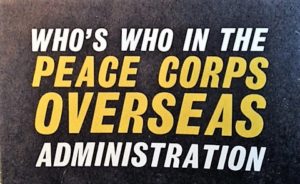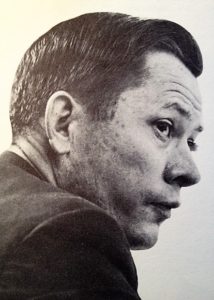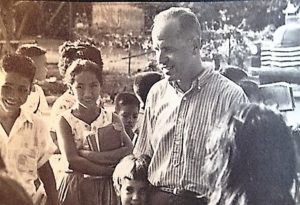Philippines’s First Peace Corps Staff (Part One)
 On its second birthday, March 1, 1963, the Peace Corps counted 624 Volunteers at work in the Philippines. Except for 22 men assigned to a rural community action program in the large southern island of Mindanao, the so-called “Texas of the Philippines,” all the Volunteers, men and women, were employed as teachers—some at the university and secondary levels but most of them in elementary schools.
On its second birthday, March 1, 1963, the Peace Corps counted 624 Volunteers at work in the Philippines. Except for 22 men assigned to a rural community action program in the large southern island of Mindanao, the so-called “Texas of the Philippines,” all the Volunteers, men and women, were employed as teachers—some at the university and secondary levels but most of them in elementary schools.
This meant that the Philippines was the setting for the largest single overseas educational program that the United States had ever mounted. It was also by a considerable margin the largest program in the Peace Corps—and would continue to be so for 10 more months.
As the Peace Corps planned the program in conformance with requests from the Philippines government—the republic served as host to 650 Volunteers by the autumn of 1963, some of whom were assigned for the first time to the lushly tropical and less developed islands of Mindoro and Palawan.
If this program was big, it had complications to match its size. The Volunteers were assigned to more than 450 schools and communities on 18 islands—all the way from Laoag in the far north of Luzon to Siasi island in the Sulu Archipelago, more than 1000 miles to the south. A pair of Volunteers were once stationed still farther south, on Tawitawi, but they were transferred because of an upsurge of pirate raids.
Communications are inevitably a problem in a nation which consists of 7,100 separate islands. For all the reliability of Philippines Air Lines’ Fokkers and faithful DC-3s, movement of both supplies and personnel is complicated by the fact that the roads all end at the ocean’s edge.
Every prospective school in which a Volunteer might teach, as well as the Volunteer’s living quarters, was first inspected by a member of the Peace Corps administrative staff, and Volunteers are visited regularly after they reach their posts of assignment.
Inter-island messages much be sent by telegram—which requires that someone drop by regularly at the telegraph offices. This was one of the circumstance which called for Volunteer Leaders, and the Leader system was first developed in the Philippines.
When the Peace Corps was still in the planning stage, Warren Wiggins, Associate Director for Program Development and Operation, prepared a monograph entitled “The Towering Task” in which he argued that the Peace Corps should send enough Volunteers to do a job, that the new agency should not court failure with programs manned in too skimpy a fashion to generate an impact.
To illustrate his argument, he referred to the Philippines with which he was familiar through years of service there in the foreign aid program. Wiggins insisted that a Peace Corps educational program in the Philippines program in which the main emphasis would be placed on halting the deterioration of the English language in the islands, would require a large number of Volunteers if it were to have any noticeable effect.
Sargent Shriver was eager to test the impact of large numbers of Volunteers in at least one nation. When in March, 1961, the Republic of the Philippines requested up to 500 Volunteers, the stage was set for the development of the Peace Corps’ first large-scale effort.
The Overseas Talent Search had not yet been organized when Shriver went looking for a man who would head up the Philippines program as Peace Corps Representative. Harris Wofford, then the President’s adviser on civil rights and Peace Corps matters, suggested a man who had once shared Wofford’s interest in the Student Federalist movement. He was Lawrence Fuchs, Dean of Faculty at Brandeis University.
Research Document: Who’s Who in the Peace Corps Overseas Administration (1963)
The photographs are by Rowland Scherman, Paul Conklin and Jim Walls, first photographers for the agency.


No comments yet.
Add your comment